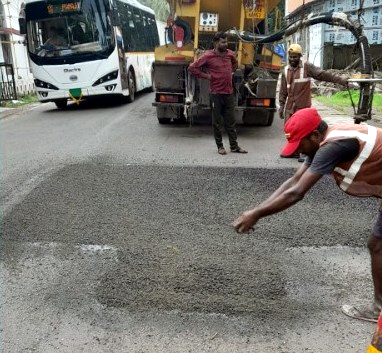Jet patchers, contractors rush to fix road stretches

QUICK FIX IN PROGRESS: A jet patcher in action, sealing broken stretches of the busy Mapusa–Green Park Hotel road at Guirim on Tuesday morning.
MAPUSA
The current lull in the monsoon has offered a much-needed window of opportunity for the Public Works Department (PWD) to expedite road repairs across Goa.
However, despite the deployment of jet patchers and road contractors, many stretches remain in poor condition, causing widespread inconvenience to commuters.
With large parts of the State reporting dry spells over the past few days, PWD teams have stepped up efforts to fill potholes and restore broken road surfaces. Jet patchers – specialised machines used to seal potholes and small cracks – are being extensively used in some areas, while road contractors have been roped in where machines are unavailable.
“What’s important is that there should be at least a few dry days like we’ve been seeing this monsoon,” said a senior PWD engineer overseeing road repair work in Bardez.
“It becomes easier for us to lay the tar properly. After pouring the tar, it must settle and grip the road surface, which is only possible in dry conditions. Otherwise, the fresh layer gets washed away by rain,” he explained.
In Guirim, the PWD was seen actively repairing a major district road from Mapusa to the Green Park Hotel. A jet patcher was in action, sealing broken sections and bringing immediate relief to motorists using the busy stretch.
However, the engineer also highlighted the limitations.
“Jet patchers aren’t available in all locations. If we wait for a machine to arrive, people get angry and we receive backlash from the public. In such cases, we hire contractors to do the job manually,” he added.
Despite these efforts, road conditions in several areas remain dismal.
The Saligao to Pilerne Industrial Estate stretch has been repaired multiple times this monsoon, only to be washed away after each spell of rain.
A similar situation prevails on the Arpora-Nagoa road, which has deteriorated again despite temporary fixes.
“We can’t do much when it rains continuously. In such cases, the only solution is to fill potholes with stones or gravel and run a road roller over them. It’s a temporary fix at best,” said another PWD official.
Motorists and residents, however, are far from satisfied.
“Every monsoon it’s the same story. The roads are patched and then washed away in a week. It’s risky and frustrating,” said Sunita Naik, a daily commuter from Calangute.
In contrast, road conditions along several National Highway (NH) stretches are significantly better.
This is attributed to the defect liability clause in NH contracts, which makes the original contractors responsible for road maintenance for up to five years.
“Most NH roads are under a defect liability period of three to five years. During this time, it is the responsibility of the contractors to address any wear and tear,” informed an NH division engineer.
Still, the core issue persists—Goa’s roads, especially internal and district roads, continue to suffer damage year after year during the rains. And while the dry spell is being used wisely by the PWD for urgent repairs, the long-term sustainability of these patchwork solutions remains questionable.
“There needs to be a holistic and durable approach to road construction in Goa. Quick fixes during the monsoon are only a band-aid. Without quality base work and proper drainage planning, the problem will keep recurring,” said a former PWD engineer.
As the State braces for heavier rains in the coming weeks, all eyes will be on how far the temporary relief can be stretched – and how soon authorities can move towards permanent solutions.